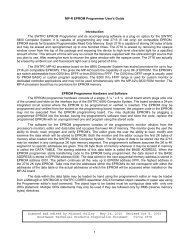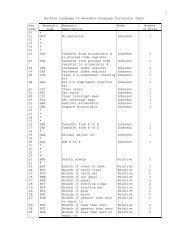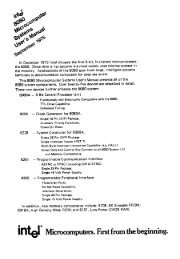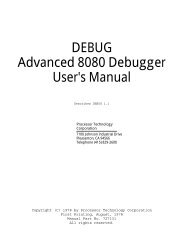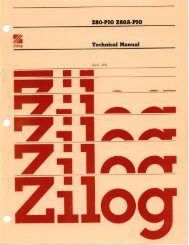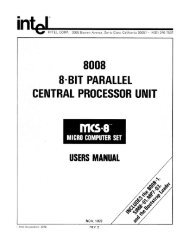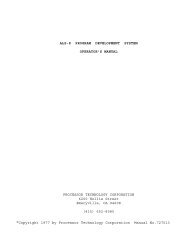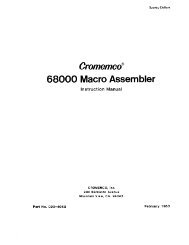The System Manual of SOL-20 - History of Computers
The System Manual of SOL-20 - History of Computers
The System Manual of SOL-20 - History of Computers
Create successful ePaper yourself
Turn your PDF publications into a flip-book with our unique Google optimized e-Paper software.
PROCESSOR TECHNOLOGY CORPORATION<br />
Sol THEORY OF OPERATION<br />
SECTION VIII<br />
KEY is fed to pin 5 <strong>of</strong> 8-input NAND gate U25, pin 9 <strong>of</strong> ROM<br />
U<strong>20</strong> and pin 1 <strong>of</strong> NAND gate U27. Let's examine the other inputs to<br />
U25.<br />
KEY, as mentioned, is fed to pin 9 <strong>of</strong> U<strong>20</strong> which is a 256 x 4<br />
bit static ROM. Only two bits are used. For each possible rowcolumn<br />
combination, there is one storage location in U<strong>20</strong>. DI1 and<br />
DO1 (pins 9 and 11) are the input and output respectively <strong>of</strong> one bit<br />
location; DI2 and DO2 serve the same functions for the other bit<br />
location. <strong>The</strong> row count is applied to A0-4 and the column count is<br />
applied to A5-7 to address U<strong>20</strong>.<br />
When a key closure is detected, the counts are presented to<br />
U<strong>20</strong> continuously. When the counts change shortly after the failing<br />
edge <strong>of</strong> !φ1, U<strong>20</strong> outputs the status <strong>of</strong> the address that is already<br />
stored in the ROM about 1 usec later on pin 10. On the rising edge<br />
<strong>of</strong> φ1 after the address change, the status on pin 10 is latched in<br />
one-half <strong>of</strong> D flip-flop U26 and presented at output pins 9 and S.<br />
About 1.5 usec later the R/W signal on pin <strong>20</strong> <strong>of</strong> U<strong>20</strong> goes low, and<br />
the KEY signal on pin 9 enters the specified location in U<strong>20</strong>. Note<br />
that this KEY is related with the new count address. <strong>The</strong> key stored<br />
in U26 represents the preceding address. We consequently call the<br />
KEY in U26 "KEY_minus_1", and it is applied to pin 11 <strong>of</strong> U25.<br />
<strong>The</strong> remaining inputs to U25 are 1) φ2 (an inverted !φ2) on pin<br />
12, 2) a repeat strobe signal on pin 4 (supplied by pin 11 <strong>of</strong> NAND<br />
gate U16 which is high without a repeat command), 3) PKD_minus_1 on<br />
pin 6 (supplied on pin 3 <strong>of</strong> U26 which is low if three or more count<br />
cycles have occurred since one key closure), and 4) the column output<br />
on pin 4 <strong>of</strong> U17 which is applied to pins 1, 2 and 3. <strong>The</strong> last<br />
signal drives the column associated with the special function keys<br />
on the keyboard (SHIFT, SHIFT_LOCK, LOCAL, BREAK, UPPER_CASE, REPEAT<br />
and CONTROL).<br />
In order for U25 to output a low on pin 8, therefore, we<br />
need a current KEY, a KEY from the preceding count cycle, no repeat<br />
function, no drive on pin 4 (column 30, hexadecimal), and we must<br />
be on the second count cycle during the current key depression.<br />
With these conditions satisfied output pin 3 <strong>of</strong> U25 goes low.<br />
It is inverted by U10 to a high on pin 11. This signal then clocks<br />
the output latches, U1 and 2. On this signal, the data present on<br />
the inputs are latched into U1 and 2, and it remains latched until<br />
the next output on pin 8 <strong>of</strong> U25 occurs.<br />
A low on pin 8 <strong>of</strong> U25 also resets one-half <strong>of</strong> D flip-flop U11<br />
at pin 13 which causes output pin 9 to go low. On the rising edge <strong>of</strong><br />
the inverted 6 usec clock from US, the second U11 stage sets and out-<br />
VIII-42



